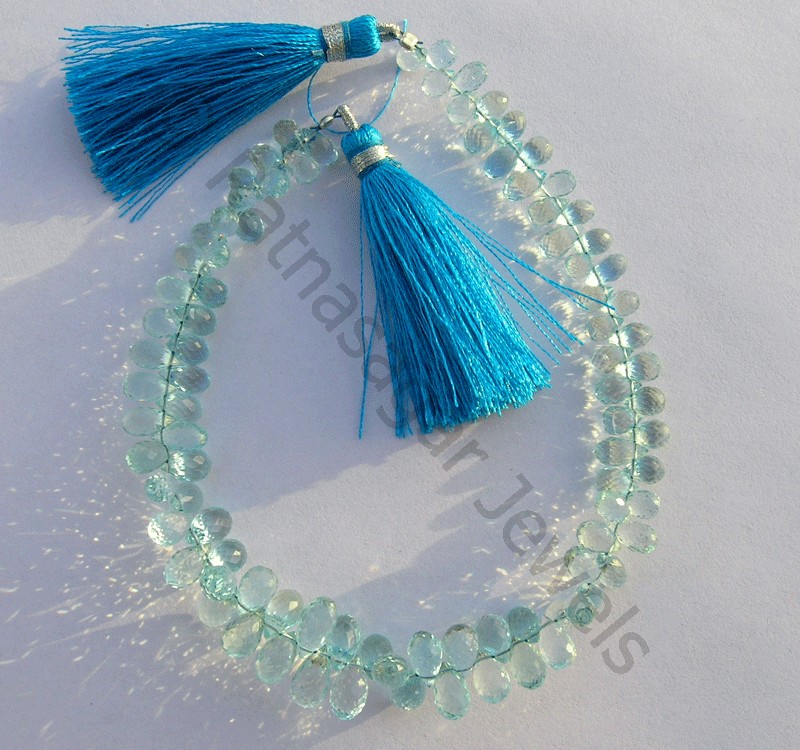13. September 2016 06:07 /
Manoj
/
Gemstone Beads
Comments
(0)
Aquamarine gemstones are exquisite items of collection, ranking at par with other blue stones like topaz and sapphire. Owing to their cost-effectiveness, they are tapped in medium-sale jewellery segments for fashion and ornaments. Often equated with Blue Topaz for the unmistakable brilliant appearance, sellers tag aquamarine gemstones at much higher price.
Before choosing your set of Aquamarine gemstones, here are 8 things you must verify before putting your bucks.
1. Color:
Aquamarine is available within a very limited colour bandwidth. It is usually pale blue, bluish-green or sky blue in colour. Sparkling blue shades are actually artificially treated gemstones. In the market, darker and intense blue coloured Aquamarine fetch higher price. If you are looking for a pure set of bead necklace, opt for gemstones with slightly greenish tinge.
2. Carat size:
Once set on the colour, move to the next deciding factor—the CARAT weight. Fashion trends suggest that single Aquamarine gemstone could be anywhere between 3-5 carat. Gemstones weighing 5 carat are most preferred by Aquamarine collectors. Smaller ones are used in beads, and sold at per-carat rates.
Since aquamarine gemstones belong to the family of semi-precious stones, sharing their reputation with the likes of emeralds, topaz, Goshenite and Beryls, it is unlikely to find pure stones in wholesale market. Irrespective of your requirements, always deal in carats from certified sellers.
3. Clarity:
Aquamarine is revered for its pristine blue clarity. It hardly has any liquid inclusion within it. However, like most beryls, they could have parallel inclusions resembling tubes and hollow tunnels. It is used by the gemstone cutters to cut the stone in such a way that it reveals Cat’s Eye effect in a more pronounced manner, fashioned into cabochons, beads, or carvings.

4. Lustre and appearance:
The gemstones and beads have a translucent appearance, which could differ in intensity depending on the cut made on them. With its vitreous lustre, it is very much possible to identify the purity of the stone used in beads. Intense vitreous Aquamarine gemstones beads are reserved for fashion industry exclusively.
5. Scratching and bubbling:
Aquamarine is a hard and durable gemstone. It can’t be etched or scratched easily. If you see scratches on its surface, it is highly likely that it is actually glass. Look for the bubbles inside its crystalline structure. Aquamarine gemstones don’t have bubbles, else it is glass.
6. Cut:
Aquamarine gemstones are cut into many shapes, however Emerald Cuts and Ovals are particularly popular among large-scale buyers. For beads, rough cuts and fantasy cuts are preferred as they prove to be least wasteful designs.
7. Light test:
Aquamarine is a pleochroic gemstone, revealing versatile colour shades when viewed in light from different angles. It is highly unlikely that the stone will look the same from different perspectives. If it does, it is glass for sure.
8. The green tinge:
Pure aquamarine gemstones have a greenish tinge. It usually disappears during heat treatment. Though they are flawless in their appearance, it is obvious that artificial gemstones are available at much lesser price in the market.
30d1163f-557d-41a6-af34-1ba8b99486fb|0|.0|27604f05-86ad-47ef-9e05-950bb762570c
Tags
: Aquamarine Beads . Aquamarine gemstones . Aquamarine gemstone Beads . Aquamarine gemstone Suppliers